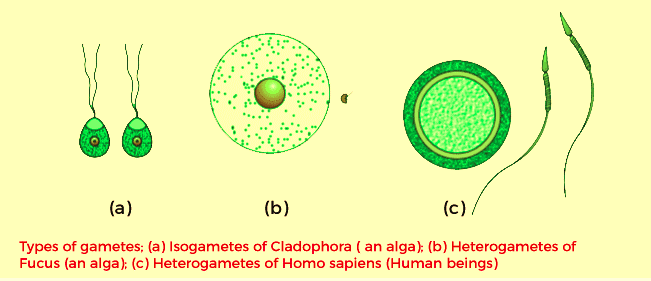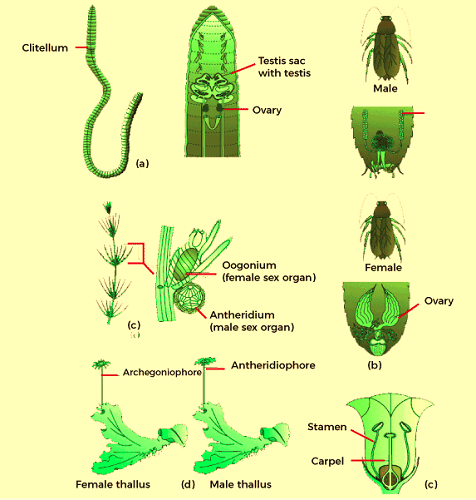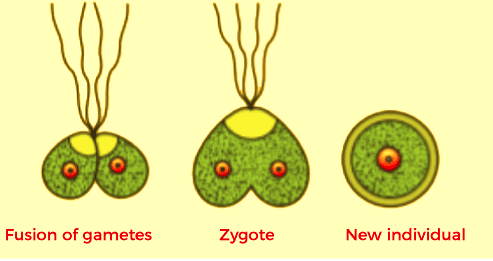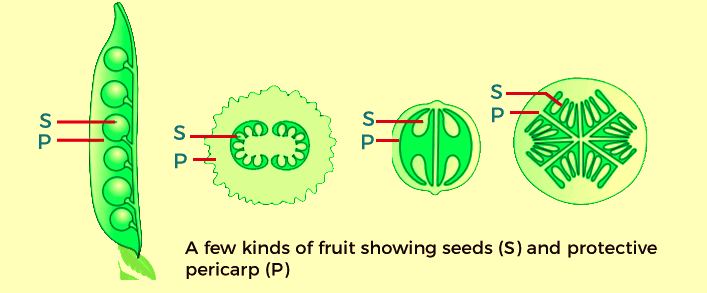Sexual ReproductionSexual reproduction involves the formation of gametes of females and males, whether by the same individual or by different individuals from the opposite gender. The gametes meld into the zygote that grows to form this new living organism. It's an intricate, complicated, lengthy, and slow process compared to asexual reproduction. Due to the fusion between gametes of males and females, sexual reproduction produces offspring that are not identical to their parents or between the parents. A look at the diverse species of plants and animals and fungi-reveals that, even though they differ significantly in external morphology, internal structure, and physiology, they all share a typical pattern in the method of sexual reproduction. We will first consider the characteristics that are common to these different species. All living things must pass the same stage of growth and maturity before they can reproduce sexually. The transitional period is known as the juvenile phase. It is also known as a vegetative stage in plants. This phase can have different duration in various organisms. The final phase of the vegetative/juvenile phase, which signifies the start of the reproductive phase, is evident in the taller plants as they begin to bloom. The plants -both the annual and biennial kinds- have clear reproductive, vegetative, and senescent phases. However, it's difficult for perennial species to identify these phases in a clear manner. Certain plants display extraordinary flowering characteristics. Some like bamboo species bloom only once during their life, and usually after 50 to 100 years, and produce lots of fruit and then die. A different plant Strobilanthus Kunthiana (neelakuranji), blooms only once in 12 years. Many of you know, this flower bloomed between September and October of the year 2006. The massive flowering transformed huge terrains throughout Kerala, Karnataka, and Tamil Nadu into blue stretches and attracted numerous tourists. In mammals, the stage of juvenile development is followed by physiological and morphological changes before the active reproductive phase. The reproductive phase is varied in duration across species. It is evident that the animals living in nature lay eggs only in the summertime. In captivity, however, the birds (as at poultry farms) are able to lay eggs all year. In this scenario, the act of laying eggs isn't related to reproduction but rather a commercial exploiting human welfare. Females of mammals that are placental show cyclical changes in the ovaries and accessory ducts and the production of hormones during the period of reproduction. In non-primate mammals such as sheep, cows, and deer, as well as rats and tigers, and so on. The cyclical changes that occur during reproduction are known as the oestrus cycle. However, in primates (monkeys and apes as well as humans) this is known as the menstrual cycle. A variety of mammals, particularly those who live in wild natural environments, have these cycles only in favourable seasons in their reproductive stage and are referred to as breeders who are seasonal. Numerous other mammals are actively engaged throughout their reproductive phase and thus are referred to as continuous breeders. The fact that we all age (if we live for long enough) is something we are aware of. The final stage of reproduction could be considered to be one of the indicators of senescence or the aging process. There are various changes that occur simultaneously within the body (like slower metabolism, etc.) during the final stage of life. The aging process eventually leads to the end of life. In both animals and plants, hormones are the primary factor responsible for the changes in the 3 phases. Interaction between hormones and specific environmental elements regulates the reproduction processes and the corresponding behaviour of animals. Events that characterize the process of sexual reproduction:When they reach the age of maturity, the organisms that reproduce sexually display processes and events that have striking similarities in their fundamentals; however, the specific reproductive structures are quite different. Sexual reproduction is distinguished by the union (or fertilization) of genders of males and females, as well as the formation of the zygote and embryogenesis. The sexual reproduction processes are complex and complicated processes, are arranged in a predictable sequence. Generally, this sequence of events can be divided into three distinct phases: pre-fertilization, fertilization and post-fertilization. 1. Pre-fertilisation EventsThey include all of the stages of sexual reproduction before the union of gametes. Two of the most important pre-fertilisation activities are gametogenesis as well as gamete transfer. i) Gametogenesis As you're aware, gametogenesis is the process of creating gametes of two kinds, both female and male. Gametes are cells that are haploid. 
In certain algae, the two gametes appear so similar in appearance that it's difficult to separate them into male or female gametes. These are referred to as homogametes (isogametes). In the large majority of organisms that reproduce sexually, the gametes that are produced have two distinct morphological varieties (heterogametes). In such species, the male gamete can be referred to as the antherozoid, also known as sperm, and gametes of females are referred to as the egg or the ovum. Sexuality in organisms: Sexual reproduction in living organisms generally refers to gametes that are merged of two distinct but similar organisms and that too isn't always the case many times. Plants could have female and male reproductive structures within an individual plant (bisexual) as well as on separate plant species (unisexual). In many fungi and plant species, the terms homothallic and monoecious are utilized to describe the bisexual state, and dioecious and heterothallic are two words used to describe unisexuality. In flowers, the unisexual male flowers are staminate, i.e., it is bearing stamens. The female flower is pistillate, or bearing pistils. In certain flowering plants, flowering males and females could be found on the same plant (monoecious) as well as on different plants (dioecious). A few examples of monoecious species are coconuts and cucurbits. Other examples of dioecious species are dates, palms, and papaya. Earthworms and sponges and tapeworms and leech, all typical bisexual species with the reproductive organs of female and male, can be described as hermaphrodites. Cockroach represents an example of a monosexual species. Cell division during the formation of gametes: Gametes in heterogametic species have two genders: male and female. Gametes are haploid, but the plant body from which they originate can be either haploid or diploid. A haploid parent creates gametes through mitotic division. 
Many Monera-related organisms' algae, fungi, and bryophytes possess a haploid plant body. Still, in gymnosperms, pteridophytes, and most animals, including humans, the parents' bodies can be diploid. It is clear that meiosis or the reduction division must happen if a diploid organism is required to produce haploid gametes. In diploid organisms, specialized cells known as meiocytes (gamete mother cells) go through meiosis. After meiosis has ended there is only one set of chromosomes is integrated into every gamete. ii) Gamete Transfer Following the formation of their gametes, the male and female gametes need to be physically connected to enable the process of fusion (fertilisation). In the majority of organisms, male gametes are moving while the female gamete remains stationary. However, there are some algae and fungi where both kinds of gametes move. There is a requirement for a medium where male gamete can move. In a variety of simple plants, such as bryophytes, algae, and pteridophytes, water is the medium by which the gamete transfer occurs. A significant portion of male gametes does not reach female gametes. To make up for this loss of male gametes in transportation, the number of male gametes manufactured is many times greater than the number of female gametes created. 
In plants that have seeds, pollen grains serve as men's gametes' carriers, and ovules produce eggs. The pollen grains produced by anthers must move to the stigma prior to being fertilized. In bisexual self-fertilising plants, e.g., peas, the transfers of the pollen grain to the stigma is quite simple because stigma and anthers are situated close to one another and pollen grains, shortly after shed meet with the stigma. However, in cross-pollinating plants (including dioecious species), the special process known as pollination assists in the transfers of the pollen grain onto the stigma. Pollen grains sprout on the stigma, and the pollen tubes that carry male gametes get to the ovule to release male gametes close to the egg. In dioecious species, because gametes of female and male form by different people, the animal has to develop a specific mechanism to transfer gametes. A successful transfer and the joining of gametes is vital for the most important stage of sexual reproduction: fertilisation. 2. FertilisationThe most crucial event in sexual reproduction may be the union between gametes. This process, which is referred to as syngamy, leads to the creation of an octoploid Zygote. It is also known as fertilisation and is commonly used to describe this kind of process. Syngamy and fertilisation are used frequently but in conjunction. But, it must be noted that female gamesters undergo developmental changes to create new organisms without fertilization in certain organisms, such as honeybees, rotifers, and some birds and lizards (turkey). This is known as parthenogenesis. In most aquatic species like a large majority of fishes and algae and amphibians, syngamy takes place in the external medium (water), i.e., outside of organism's body. This kind of gametic fusion is known as external fertilization. Organisms that show external fertilisation exhibit amazing synchrony between sexes and release a lot of gametes into their environment (water) to improve the odds of syngamy. This is the case with bony fishes and frogs, where numerous offspring are born. The main disadvantage is that offspring are very susceptible to predators that could threaten their existence up to the age of adulthood. Many terrestrial species belong to fungi, reptiles, higher animals, birds, mammals, and in the majority of plants (bryophytes, pteridophytes and gymnosperms, and angiosperms), Syngamy takes place inside an organism's body. In all of these organisms, eggs are formed in the female organs which is where they join their male gametes. Hence, this process is known as internal fertilization. For organisms with internal fertilisation, the male gamete is mobile and must reach the egg to join with it. In these, even while the number of sperms produced is huge, there is a substantial reduction in the number of eggs created. However, in the seed plant, the male gametes that are not motile are transferred to female gametes by pollen tubes. 3. Post-fertilisation EventsThe events that occur in sexual reproduction following the creation of a zygote are known as post-fertilisation events. i) The Zygote The formation of the diploid zygote is common in all species that reproduce sexually. For organisms with external fertilization, the zygote is produced in the outside medium (usually water); however, it is created within an organism's body in those with internal fertilization. The growth of the zygote is contingent on the kind of life cycle that the organism goes through and the type of environment that it's exposed to. In fungi-related organisms and algae, the zygote builds an extremely thick wall that is impervious to damage and desiccation. It is subjected to a time of relaxation before the process of germination. In organisms with a haplontic life cycle, the zygote divides via meiosis, resulting in haploid spores that develop into individual haploids. The zygote is the crucial connection that ensures the continuity of species between species from one generation and the following generation. All sexually reproducing organisms, such as human beings, begin life as a single cell, the zygote. ii) Embryogenesis The term "embryogenesis" refers to the process of developing embryos that arise from the zygote. In the process of embryogenesis, the zygote undergoes cells division (mitosis) and differentiation of cells. Cell divisions boost the number of cells present in the embryo's development. Cell differentiation allows groups of cells to undergo certain changes to form specific organs and tissues to make an organism. Animals are categorised into oviparous and viviparous based on whether the development of the zygote takes place outside the body of the female parent or inside, i.e., whether they lay fertilised/unfertilised eggs or give birth to young ones. In reptiles that are oviparous, such as snakes and birds, fertilised eggs, which are covered with hard calcareous shells, lay in a secure location in the natural environment. Following a time of incubation, the eggs hatch. However, in viviparous animals (majority of mammals and humans), the zygote grows into a new one within an organism that is female. When it is at a certain point of development, the new ones are released from the female organ. With proper embryonic care as well as protection probability of survival for young children is higher in viviparous species. In flowers, the zygote forms within the Ovule. After fertilization, the sepals, stamens, and petals of the flower dwindle and drop off. The pistil, however, remains connected to the plant. The zygote transforms into an embryo, and the ovules form into seeds. The ovary grows into a fruit that develops the pericarp, a wall of thickness that serves as a protective layer. Following the dispersal of seeds, they sprout under conditions that are favourable to create new plants. 
Next TopicSexual Reproduction in Flowering Plants
|
 For Videos Join Our Youtube Channel: Join Now
For Videos Join Our Youtube Channel: Join Now
Feedback
- Send your Feedback to [email protected]
Help Others, Please Share









